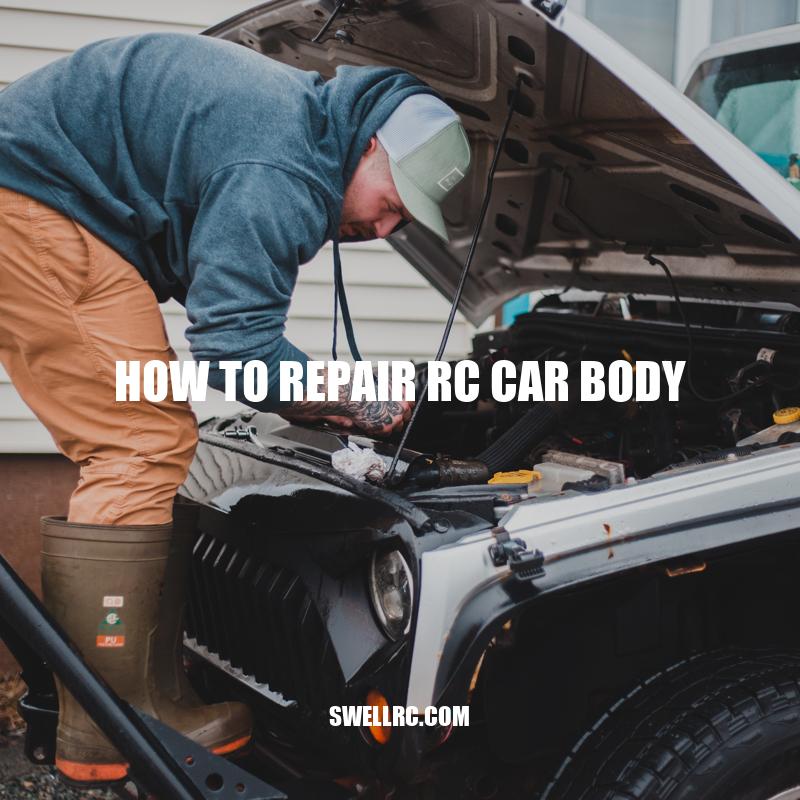RC Car Body Repair: How-to Guide
RC cars are a great way to experience the thrill of racing from the comfort of your own home. However, like any other vehicle, they require regular maintenance and repairs to keep them in top condition. One of the most important aspects of RC car maintenance is keeping the body in good shape, as it not only improves the appearance but also protects the internal parts. If you’ve been neglecting the body of your RC car, don’t worry; in this article, we’ll walk you through the process of repairing an RC car body, so you can get back to racing in no time! Here, we’ll take you step-by-step through the process, from assessing the damage to reassembling the body after repairs. By the end of this article, you’ll have all the knowledge and skill you need to give your RC car’s body some much-needed care and attention. So, grab your toolbox, put on some work gloves and let’s get started with repairing your RC car body!
Assess the Damage
Before you start repairing your RC car body, it’s essential to assess the extent of the damage caused. Here’s what you can do:
- Inspect the RC car body’s paint job, decals, and other design elements to determine if they need to be replaced.
- Check if there are any dings or structural damage that may affect the car’s operation.
- If you can find any cracks or splits, determine the size and the number of cracks.
- If your RC car body is too damaged to fix or beyond repair, then it may be time to consider purchasing a new one.
If you need to purchase a new RC car body, there are plenty of websites and online stores that offer a broad range of options. Amazon and eBay are great places to start. You can also check some popular RC car brands like Traxxas, Axial Racing and Tekno RC, as they offer high-quality replacement parts.
Can You Repaint RC Body?
Yes, you can easily repaint an RC body with the right tools and techniques. Here are a few things to keep in mind:
- Choose a paint that is specifically designed for lexan, the material used for most RC bodies.
- Prepare the surface of the body by cleaning it thoroughly and sanding lightly to create a rough surface for the paint to adhere to.
- Use a spray paint gun or airbrush for the best results and to avoid brush marks.
- Apply multiple thin coats until the desired color and finish is achieved.
- Allow each coat to dry completely before applying the next.
- Protect the paint by clear-coating the body once the paint has fully cured.
If you need further guidance, some RC hobby websites offer tutorials and step-by-step guides for repainting RC bodies. Additionally, there are lexan spray paints and clear coats available for purchase online or at your local hobby store.
Remove the Body from the Chassis
Before you can start repairing your RC car body, you need to remove it from the chassis. Here’s how to do it:
| Tools Required | Instructions |
|---|---|
| Screwdriver | Remove all the screws from the body and the chassis. |
| Tweezers or pliers | Carefully remove any small parts like body clips or pins. |
| Body Reamer | Run the body reamer along the body posts to release the body shell or use the clipping mechanism in some models. |
| Be sure to keep all the screws and small parts in one place like a tray or a container for easy reassembly later. | |
Removing the body can also give you a chance to clean the interior and examine the chassis, which can help you assess if further repairs or maintenance are required.
How do you restore an RC body?
If you have an RC body that has seen better days, there are a few things you can do to restore it to its former glory:
- Wash the body with soap and water to remove any dirt or debris.
- Use a plastic polish to remove any scratches or scuffs on the body.
- If the body is cracked or broken, use a plastic repair kit to fix it.
- Paint the body with a new color or design if desired.
Some helpful products for this process include plastic polish from Meguiar’s or Mothers, plastic repair kits from PlastiFix, and RC car paint from Tamiya.
Remember to follow the manufacturer’s instructions for any product you use and take your time to ensure a quality restoration.
Repairing the Body
Now that you have removed the shell, it’s time to repair any damages. Here are some steps to follow:
- Clean the damaged area: Use a cloth or brush to gently remove debris or dirt from the damaged area.
- Sand the surface: Use sandpaper or a sanding block to smooth rough edges and create a surface to adhere the patching material.
- Patch the damage: Use a plastic patch kit or putty to cover and fill any dents, cracks or holes in the body.
- Reinforce the area: Use fiberglass tape or cloth to create extra reinforcement on the inside of the body. This will help prevent further damage and strengthen the body if it’s thin in certain spots.
- Allow the patching material to dry properly before sanding and painting.
There are many RC car body repair kits and materials available online or in local hobby shops. Be sure to choose the right kit or supplies that match the material of your body.
How do you fix a crack in a car body?
Fixing a crack in a car body involves the following steps:
- Identifying the extent of the damage – small cracks can be repaired while larger ones may require replacement of the entire panel.
- Cleaning the area around the crack – this involves removing any dirt or debris that could affect the repair process.
- Sanding the area – this ensures that the surface is smooth and that the filler used adheres properly.
- Applying filler – fillers are used to fill the crack and make the surface smooth.
- Sanding the filler – this ensures that the surface is even and smooth as well as removing any excess filler.
- Painting the repaired area – this gives the repaired portion a similar appearance to the rest of the car body.
If you lack the necessary skills and tools to undertake the repair, it is advisable to seek the help of a professional.
For those looking for products to fix a crack in a car body, there are various options available, such as filler putty, fiberglass repair kits, and body filler. Visit your local auto parts store or online retailers such as Amazon to check out the options available.
Sanding and Painting
Once the body is repaired and cleaned, it’s time to sand and paint the surface. Here’s how to do it effectively:
- Sand the surface with a fine-grit sandpaper to remove any bumps, lumps or rough texture on the surface of the body.
- Clean the shell: Take a cloth and wipe off any dirt or dust from sanding or rubbing.
- Prepare the surface: Use a primer to give the paint a better grip on the surface. Use even strokes and make sure to cover the entire surface.
- Paint the body: Once the primer is dry, use a high-quality paint specifically designed for RC car bodies. Apply in thin layers and allow each layer to dry before applying another one.
- Allow the paint to dry completely and apply a clear coat to seal in the paint job and give it a glossy finish.
There are many types of paint you can use depending on what effect you want to achieve. Some enthusiasts use special masking tape and stencils to create unique designs or patterns. You can find a variety of RC car painting supplies online or at hobby shops.
How do you smooth paint on a surface?
- Use a high-quality brush or roller to apply the paint evenly.
- Sand any rough spots or bumps on the surface before painting.
- Apply a second coat of paint if needed to even out any imperfections.
For more tips on painting and DIY projects, check out websites like BobVila.com or DIYNetwork.com. For painting supplies, consider visiting your local home improvement store or ordering online from retailers such as Home Depot or Lowe’s.
Reassembling the Body
Once the body has dried and the paint has cured, it’s time to reattach the body to the chassis. Here’s how to do it:
- Gently lift the shell and place it over the chassis, making sure it aligns with the mounting holes on the chassis.
- Secure the body to the chassis using the screws and other small parts you removed earlier. For best results, tighten the screws gently to avoid over-tightening or stripping the threads.
- Reattach any accessories, such as mirrors or spoilers, that you removed before the repairs.
- Test the body by moving the wheels to ensure that they don’t rub against the body or cause any other issues.
- If everything is in working order, you can take your newly-repaired RC car for a spin!
If you need replacement parts, you can find them online or at your local hobby shop. Make sure to get the right parts for your RC car brand and model, as using the wrong parts can cause issues with fit, performance, and safety.
What is the difference between car body and chassis?
Car body and chassis are two essential components of an automobile. Here are the differences between them:
- The car body is the outer shell that encloses the cabin, engine, and other components. It is made of sheet metal or composite materials and typically includes the doors, bumpers, hood, and trunk.
- The chassis is the framework that supports the car body and all its components. It includes the engine, transmission, suspension, steering, and wheels.
- The chassis provides structural strength and rigidity, while the car body provides protection and aesthetics.
- Modern cars often have integrated body and frame designs, where the two components are welded together as a single unit, such as a unibody construction.
If you are interested in learning more about car components, check out websites like Cars.com and AutoZone.com that offer detailed information about cars and car parts.
Conclusion
Repairing an RC car body may seem intimidating, but it’s a rewarding experience that can extend the life of your car and save you money on repairs. With the right tools and replacement parts, you can fix most issues and get your car back on the road in no time. Remember to always take your time, follow the instructions carefully, and use high-quality materials so that your repairs last a long time.
Additional Tips
- Store your RC car in a cool, dry place to prevent damage and wear and tear.
- Use a protective covering, such as a clear coat or film, to prevent scratches on your RC car’s body.
- Regular maintenance, such as cleaning and oiling the car’s moving parts, can help prevent or minimize issues with your RC car.
Where to Find Help
If you’re unsure about how to repair your RC car body, you can find help online or at your local hobby shop. Many online communities and forums are dedicated to RC car enthusiasts and can provide advice and support. You can also find tutorials and how-to videos on YouTube or other online resources.
Repairing your RC car body may take time and effort, but it’s a fun and worthwhile endeavor that can enhance your enjoyment of the hobby. Happy repairing!



